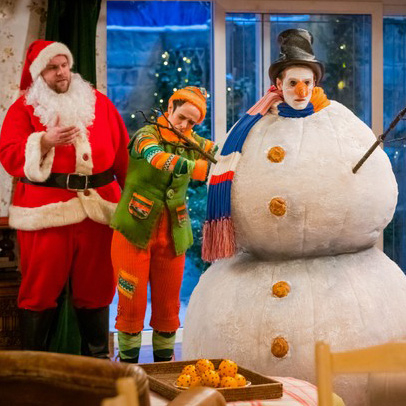Jonathan Sayer knows a lot about things going wrong. When he was a child, he served a stint playing the young street urchin Gavroche in the hit musical Les Misérables. One night, during his death scene, he fell to the floor and landed on the revolving stage. “My hair got caught in the innards of the revolve and was torn out. But the show went on. People kept singing. I had to just lie there, because I was supposed to be a dead body, but I was, like, ‘Argh, my hair!’”
It was a formative moment for Sayer, who realised, after the agonising pain had subsided, that things going wrong on stage can be funny.
Carefully Choreographed Calamity
A decade later, he, Henry Lewis and Henry Shields, all Lamda graduates, wrote The Play That Goes Wrong and debuted it at the Old Red Lion Theatre in Islington, north London, in 2012. It was a hit, eventually moving to the West End and winning Olivier and Tony awards. The trio formed a company, Mischief Theatre, that went on to produce The Comedy About a Bank Robbery and Peter Pan Goes Wrong. The BBC commissioned two specials to see if their brand of carefully choreographed calamity would translate to the screen, and, broadly speaking, it did. So now, as Mischief Screen, Sayer, Lewis and Shields have been granted an entire series.
The Goes Wrong Show consists of six plays. The premise is that the BBC has offered a middling local dramatic society the chance to film a series of productions, ranging from a heart-warming Christmas episode to a spine-tingling horror. In every case, things quickly descend into failure and farce as props break, doors won’t open and people repeatedly fall over. Pompous actors flounder and flounce because the show must go on. It is unashamedly silly and, at the same time, a reminder that physical comedy honed to perfection, à la Charlie Chaplin or Mr Bean, will never go out of fashion.
“People maybe want a bit of escapism right now, and we’re able to offer that,” Sayer explains. “We’re not saying witty things and asking people to laugh along with us. We are just saying, ‘Come and laugh at these fools for half an hour.’”
It is unashamedly silly and, at the same time, a reminder that physical comedy honed to perfection will never go out of fashion.
Mischief’s brand of foolishness is, of course, decidedly clever. First, making stuff go wrong on cue requires studious preparation. Shows are recorded in front of a live studio audience, but not the most dangerous stunts, which require three weeks’ rehearsal and a level of technical mastery you wouldn’t find in a sitcom. To watch Lewis, who is a big man with an air of Brian Blessed at his most bombastic, crash down stairs without breaking his back is to see the culmination of several months of careful choreography.

“The challenge has always been to try to recreate on television what we had in the theatre, because everything started out as a theatre show,” Lewis says. “You get a lot more intimacy in the theatre, a lot more connection with the audience, and you have to work out a way of doing that on TV. It’s not so simple.”
Not only do they use a real studio audience, they make sure viewers at home can see it. “You keep reminding them that, for the purposes of the actors, it’s live,” Lewis says.
Some Diagrams Have Been Misread
“It’s not an easy show to make, this one,” agrees Hilary Strong, the chief executive of Mischief Screen. “You’ve got half-hour comedy budgets, which are tight, but unlike most sitcoms, where you’ve got the same set and the same costumes, every week is completely different. So you’ve got to reinvent it every single time.”
Mischief haven’t made it easy on themselves. The final programme of the series, for example, imagines that the set builders have misread some diagrams. As a result, one of the sets has been built with everything turned at an angle of 90 degrees. Tables are on walls, windows are in ceilings and actors have to be strapped into chairs. To counteract the builders’ error, the premise continues, cameras have been mounted on their side, meaning that, despite the correct orientation, water, hair and often people fall to the bottom of the screen.
“We wrote it,” Sayer says, “and then no one knew how to do it.” On my visit to warehouses at Elstree Studios, where the group develops and builds the sets, Dennis de Groot, the show’s production designer, was most proud of a system that allowed a remote-controlled dog to walk (unconvincingly) across the ceiling.
“Assuming we achieve it,” Shields says, once he has been released from a chair in which he has been harnessed at a 90-degree angle for 20 minutes, “the final episode will be a technical marvel.”
Have Pratfall, Will Travel
Mischief’s take on modern slapstick is shrewd. In an age when television needs to be sold around the world to pay its way, drama is king; TV comedy generally doesn’t travel very well. Edgy or political comedy, no matter how good, only works within a small geographical sphere, whereas Buster Keaton, Johnny English and Chaplin work everywhere. The Play That Goes Wrong has been licensed to 38 countries for local-language versions. It has been particularly successful in China, and the rights to make a Chinese-language version of the television show have already been sold, says Strong, who spent almost 14 years at Hat Trick, the production company behind Have I Got News for You.
“Physical comedy works outside the UK,” she continues. “These boys are commercially bright as well as creative. There hasn’t been a young group of people doing this kind of comedy for a very long time. What they’re doing, I believe, will travel.”
And, if it does, it will be Mischief’s greatest disaster yet.

